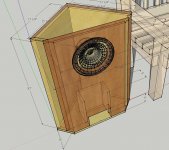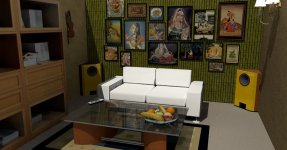Hey guys, I finaly found a plan for my widerange drivers.
A set of Goodmans Axiom 10's, sadly I don't know much about speaker design, just enough to know how little I know.
Can you tell me more about this reflex enclosure, like what its resonant points are and how low it goes etc... even if you think its still a good design by today's standards.
I intent to get the original tweeters/horns that came with these drivers too and has slots provided for in the box plan. it comes with a built in crossover and some sort of level control knob.
The enlosure is about 5000cubic inch (82litres), the port dimensions are as follows. 9" high, 7" wide and 4" deep, with a 4"x7" mouth on the side... would that 9" be reduced by the thickness of the face panel I choose?
I want to build the corner one...


A set of Goodmans Axiom 10's, sadly I don't know much about speaker design, just enough to know how little I know.
Can you tell me more about this reflex enclosure, like what its resonant points are and how low it goes etc... even if you think its still a good design by today's standards.
I intent to get the original tweeters/horns that came with these drivers too and has slots provided for in the box plan. it comes with a built in crossover and some sort of level control knob.
The enlosure is about 5000cubic inch (82litres), the port dimensions are as follows. 9" high, 7" wide and 4" deep, with a 4"x7" mouth on the side... would that 9" be reduced by the thickness of the face panel I choose?
I want to build the corner one...
An externally hosted image should be here but it was not working when we last tested it.
An externally hosted image should be here but it was not working when we last tested it.


Attachments
Last edited:
Nothing guys?
As far as I can tell the box should be good for 40Hz, but I'm totaly lost on the port thing.
Just look how cool these ol things can still look today... I mad a picture in sketchup for inspiration...Oh and also to compare to the rectangular box, which looks horrible.
As far as I can tell the box should be good for 40Hz, but I'm totaly lost on the port thing.
Just look how cool these ol things can still look today... I mad a picture in sketchup for inspiration...Oh and also to compare to the rectangular box, which looks horrible.
Attachments
Hi digits,
the resonance frequency of the box is calculated as ( Helmholtz resonance - Wikipedia, the free encyclopedia ):
Fs = (v/2*PI)*sqrt(A/(V*L))
where:
Fs: box resonance frequency
v: speed of sound in air (at 20°: 344 m/s)
A= section area of the reflex conduct port (4"x7")
V= box internal net volume ( internal volume - reflex conduct volume - speaker driver volume )
Hope this helps
the resonance frequency of the box is calculated as ( Helmholtz resonance - Wikipedia, the free encyclopedia ):
Fs = (v/2*PI)*sqrt(A/(V*L))
where:
Fs: box resonance frequency
v: speed of sound in air (at 20°: 344 m/s)
A= section area of the reflex conduct port (4"x7")
V= box internal net volume ( internal volume - reflex conduct volume - speaker driver volume )
Hope this helps
Hi,
all the units in the formula should be coherent, i.e. all expressed in inch or centimeters (or meters).
So, converting all units in centimeters (squared for areas, cubic for volumes):
V (box internal net volume) = Vbox - Vconduct
where, approximately (by defect, considering the box a triangular prism to semplify calculation (*) ):
Vbox = 1/2*B*H*L
B (triangle base)=18"=45.7cm
L (prism length, ie box height)=30"=76.2cm
H (triangle height)=45.4cm
Vbox=1/2 * 45.7 * 76.2 * 45.4 = 79050 cm^3
Vconduct = Throat area (4"*7") * Conduct length (9")= 180.7 cm^2 * 22.8 cm = 4130 cm^3
V = 79050 - 4130 = 74920 cm^3
In theory we should subtract also the volume of the speaker driver but I won't do it (having already approximated by defect the box volume).
Now to calculate Fs, we need to convert v in cm/s for dimensional coherence:
v = 344 m/s = 34400 cm/s
Fs = (v/2*PI)*sqrt(A/(V*L))
Recapitulating:
A (conduct throat area) = 4" * 7" = 180.7 cm^2
V (box net volume) = 74920 cm^3
L (conduct length) = 9" = 22.8 cm
Fs = 5477 * sqrt(180.7/(74920*22.8)) = 5477 * sqrt(0.000105785) = 5477 * 0.10285= 56Hz
Please, remind that this is only theory, in practice to calculate the resonance frequency of a bass reflex tube is normally used a correction factor for the tube length.
Furthermore, I don't know if in this case it's correct to consider the length of the conduct as 9", from the throat (the top of the conduct) to the mouth bottom, or if it's more correct to consider it 7" (from the throat to the mouth middle).
Moreover, keep in mind that I'm a novice in acustic, so it's possible that I've done some misassumption. It should be kind if someone could confirm what I wrote is fine.
(*) whereas in reality it should be seen as a composition of two scalene and one isosceles triangular prism, or three isosceles triangular prism plus a parallellepiped
all the units in the formula should be coherent, i.e. all expressed in inch or centimeters (or meters).
So, converting all units in centimeters (squared for areas, cubic for volumes):
V (box internal net volume) = Vbox - Vconduct
where, approximately (by defect, considering the box a triangular prism to semplify calculation (*) ):
Vbox = 1/2*B*H*L
B (triangle base)=18"=45.7cm
L (prism length, ie box height)=30"=76.2cm
H (triangle height)=45.4cm
Vbox=1/2 * 45.7 * 76.2 * 45.4 = 79050 cm^3
Vconduct = Throat area (4"*7") * Conduct length (9")= 180.7 cm^2 * 22.8 cm = 4130 cm^3
V = 79050 - 4130 = 74920 cm^3
In theory we should subtract also the volume of the speaker driver but I won't do it (having already approximated by defect the box volume).
Now to calculate Fs, we need to convert v in cm/s for dimensional coherence:
v = 344 m/s = 34400 cm/s
Fs = (v/2*PI)*sqrt(A/(V*L))
Recapitulating:
A (conduct throat area) = 4" * 7" = 180.7 cm^2
V (box net volume) = 74920 cm^3
L (conduct length) = 9" = 22.8 cm
Fs = 5477 * sqrt(180.7/(74920*22.8)) = 5477 * sqrt(0.000105785) = 5477 * 0.10285= 56Hz
Please, remind that this is only theory, in practice to calculate the resonance frequency of a bass reflex tube is normally used a correction factor for the tube length.
Furthermore, I don't know if in this case it's correct to consider the length of the conduct as 9", from the throat (the top of the conduct) to the mouth bottom, or if it's more correct to consider it 7" (from the throat to the mouth middle).
Moreover, keep in mind that I'm a novice in acustic, so it's possible that I've done some misassumption. It should be kind if someone could confirm what I wrote is fine.
(*) whereas in reality it should be seen as a composition of two scalene and one isosceles triangular prism, or three isosceles triangular prism plus a parallellepiped
Oh man you are awesome!
I used sketchup to model the internal space and its something like 5002 Cubic inch...or (81.991654.53 mm3) according to the entity properties... but otherwise I think I can work the stuff out now.
Just one question remains, the port is a 9" long tube with a SIDE opening at the bottom, which is 4 inches of the tube's lenght, would it thus make sense to say the port is 5 inches long?
And lets say I add a 2" face to the box, should I take the 2" off the top of the port then to keep the original lenght?
I used sketchup to model the internal space and its something like 5002 Cubic inch...or (81.991654.53 mm3) according to the entity properties... but otherwise I think I can work the stuff out now.
Just one question remains, the port is a 9" long tube with a SIDE opening at the bottom, which is 4 inches of the tube's lenght, would it thus make sense to say the port is 5 inches long?
And lets say I add a 2" face to the box, should I take the 2" off the top of the port then to keep the original lenght?
Last edited:
Ok, with the correct box volume (actualy still need to deduct the port panels) it comes to 54Hz, useing the same port lenght, and I see that the longer the port gets, the lower the frequency gets.
Now is this point the F3 point or the point at which the box will resist any lower frequencies..?
I 'd have imagined such a large box would go lower.
Now is this point the F3 point or the point at which the box will resist any lower frequencies..?
I 'd have imagined such a large box would go lower.
Back then it was common to tune a cab between Fs and a 1/2 octave away with a 1/4 octave being popular with some, which is close enough to what this one is based on a 45 Hz Fs. This tuning helps ensure that there's adequate acoustic [box] protection right above Fs.
Fb = F6, though the box doesn't resist a lower signal, it lets it through unabated, rapidly over-excursing the driver to destruction if there's no electrical means to protect it. Nifty animation of driver, vent action: Essay
Back then though, there were precious few recordings with enough content below 45-50 Hz to cause any problems except for TT 'rumble', so if you had a good quality TT, then typically you didn't need a 'rumble' filter.
Still, some manufacturers such as Altec, JBL used drivers with a much lower Fs with cabs tuned accordingly to ensure no such problems, so when the digital age came along they continued to do just fine except for movie soundtracks with < 20-25 Hz LFE content.
GM
Fb = F6, though the box doesn't resist a lower signal, it lets it through unabated, rapidly over-excursing the driver to destruction if there's no electrical means to protect it. Nifty animation of driver, vent action: Essay
Back then though, there were precious few recordings with enough content below 45-50 Hz to cause any problems except for TT 'rumble', so if you had a good quality TT, then typically you didn't need a 'rumble' filter.
Still, some manufacturers such as Altec, JBL used drivers with a much lower Fs with cabs tuned accordingly to ensure no such problems, so when the digital age came along they continued to do just fine except for movie soundtracks with < 20-25 Hz LFE content.
GM
Hi Freddi. I think I own these EXACT speakers. Where did you find the photo? I keep them in my workshop and rotate them in periodically. I'm thinking of trying to repurpose the TwinAxiom into a wideband 3-way with assist on highs and lows. It extended high enough until my 3-year old took a liking to the whizzer cone. uhoh!
I have a pair of twin axiom 10's in very good condition a few pin holes in the suspension but nothing that cannot be made as new again. These need a good home. I would love to see them in a Karlson Kabinet. Sorry I cannot take pictures. $35.00 USD the pair plus actual postage and transaction fees. contact me at moray james cables at yahoo dot com.
- Status
- This old topic is closed. If you want to reopen this topic, contact a moderator using the "Report Post" button.
- Home
- Loudspeakers
- Full Range
- Goodmans Axiom 10 reflex cabinets.


